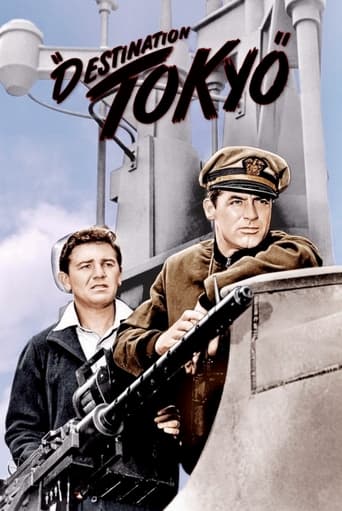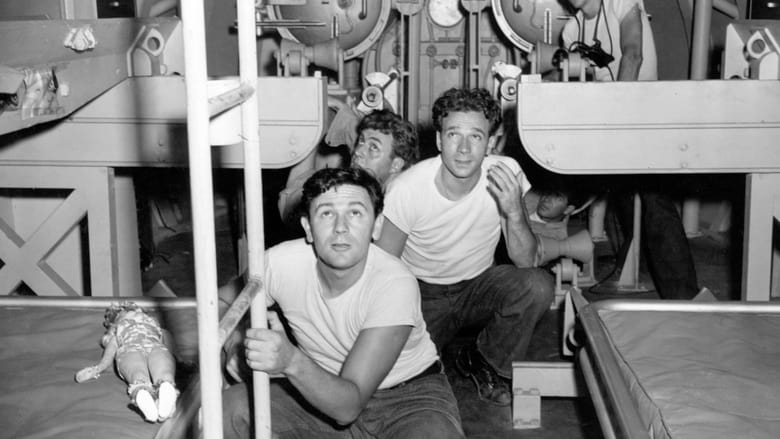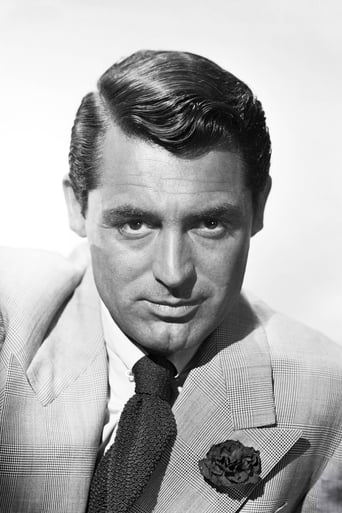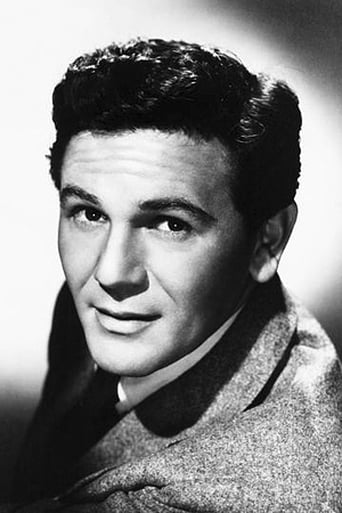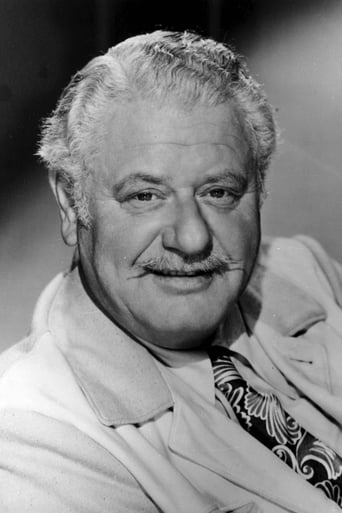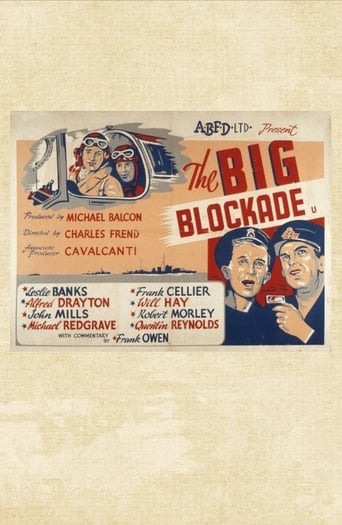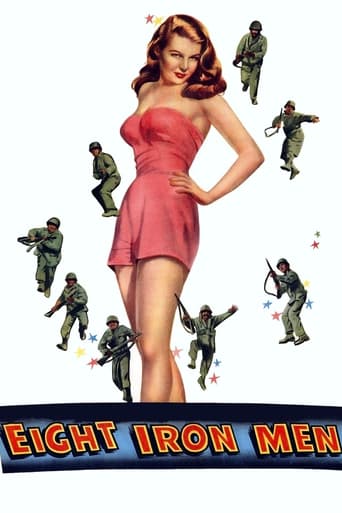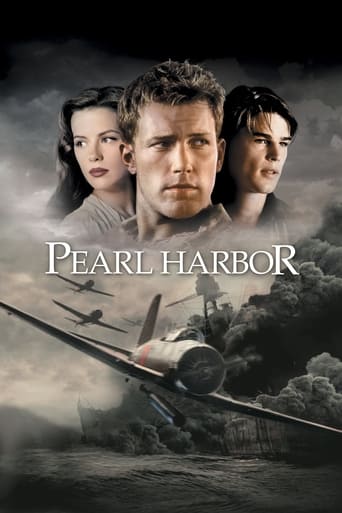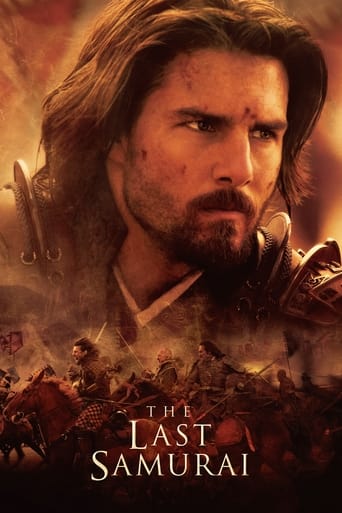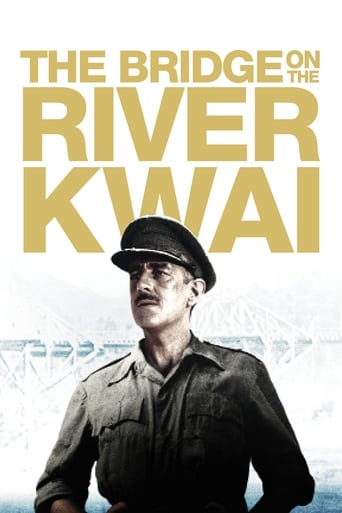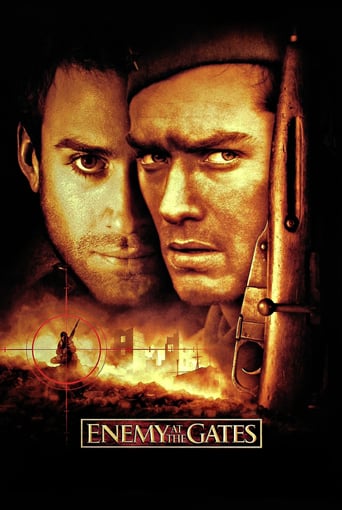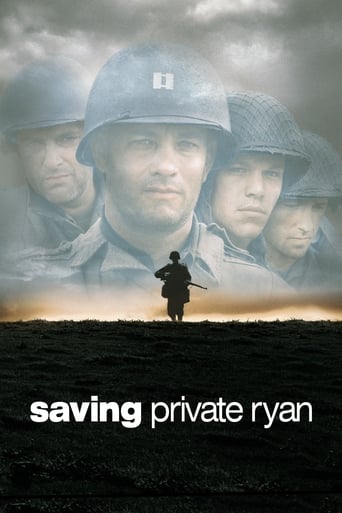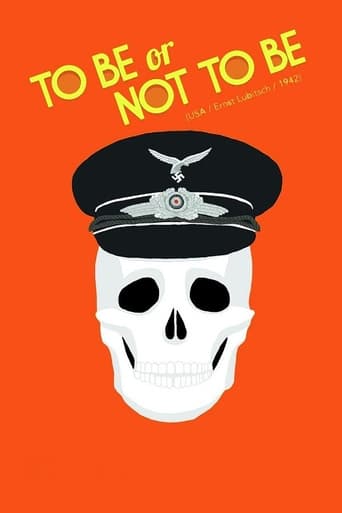Destination Tokyo (1943)
During World War II, Captain Cassidy and his crew of submariners are ordered into Tokyo Bay on a secret mission. They are to gather information in advance of the planned bombing of Tokyo. Along the way, the crew learn about each other as they face the enemy and some of them lose their lives.
Watch Trailer
Cast


Similar titles
Reviews
This movie is the proof that the world is becoming a sick and dumb place
Surprisingly incoherent and boring
One of my all time favorites.
Simple and well acted, it has tension enough to knot the stomach.
When watching this movie people MUST keep in mind the times it is set in. We have to remember the attacks on all of the the U. S. Territories, drawing us into WW II. That statement would not be necessary if the younger generations had not been fed the revisionist history of the last 40 years. As far as goofs, they start almost from the beginning. 1. The escorts for the Commander taking the message to the "Coding Room", the guard on the Commander's left is out of step. Big no-no. 2. At the entrance to the "Code Room" there is a .45 pistol in holster on a Web belt hanging on the coat tree. There is an armed guard in the room, but would a military person leave a weapon there? I don't think so. 3. When the sub's C.O. is writing his letter to his wife, he tells her they are leaving, on an important mission. I'm not sure this would pass the censors. 4. All through the formation Tin Can is chewing gum. Not in formation he isn't. 5. One of the crew members is wearing a leather jacket with the collar up during the formation. 6. When the executive officer enters the Captain's quarters, he has both hands in his pockets. Not happening. 7. When the kid asks Mike why the Captain doesn't wear his decorations, Mike responds that he doesn't have to. Any awards or medals are part of his uniform, once they are issued and placed in his records. 8. It looks sort of stupid having the side of the kid's locker left off, the camera would have framed his face much better without the distraction caused by leaving the side off. 9. Whenever the sub dives, it only takes 2 full rotations of the latch to properly close the hatch. After the shore personnel are gone and the sub begins it's dive, the latch is turned 4 full rotations. I don't know the proper number of rotations it truly takes, but they should have kept it consistent. 10. When they are attacked by the 2 Japanese aircraft, the boat's Captain tells the men to pick up the surviving pilot. Why? What are they going to do with him after they question him? They can't interrupt their mission to drop him off, and they wouldn't take him along on the mission. Any number of thing could happen with him on board up to and including sinking the sub. I don't think there would have been any qualms about shooting him, or leaving him floating, especially since the Japanese pilots during their attack on Pearl Harbor were strafing the sailors that were in the water or in lifeboats. There were more goofs, but this is enough. Still a good movie.
Destination Tokyo is big slap in the face for those who died in the Pacific War.Yet again, Hollywood rewrites history to make it look like America alone won the Second World War! This really is an awful movie that spectacularly distorts the history of the Battle of the Pacific (just as U-571 distorts the history of the Battle of the Atlantic) and, as a proud Briton, I find it downright insulting to my nation and it's efforts during the Second World War. Britain didn't need America's help. We had everything under control, thanks to Prime Minister Neville Chamberlain's peace treaty he personally negotiated with Herr Hitler. But no, America had to interfere. All we had to do is sign a peace treaty with Tokyo, too, and there would have been no war. But America couldn't leave well enough alone.Destination Tokyo is filled with historical inaccuracies, and totally ignores even the basic historical facts concerning the true story of the War. And with all of the other factual errors, distortions, and cultural stereotypes, this is about as far from being even a semi-accurate depiction of the war at sea as you will ever get.Das Boot sets the standard by which all submarine movies are judged. And Destination Tokyo is just another second rate Hollywood knockoff of Das Boot, like U-571 (see my review of U-571). It has to be criticized that they tried to copy the German film, which was so successful, with the difference that the heroes are Americans. What's wrong with having Germans or the Japanese being the heroes, Yanks? They fought, too, you know! It's not just all about you, America. If you want a movie that has no basis in reality and just panders to national stereotypes and American patriotic jingoism, then you'll probably enjoy this movie - Just remember that what you are watching is complete fiction and not in any way a representation of true history. However, if you want something that accurately depicts submarine warfare during the Second World War, you'd be far better advised to watch Das Boot instead.The CGI effects are pretty lame, too. They were made in black and white. I guess they are trying to pretend this film was made during the Second World War. Spoiler alert:Britain defeated Japan and won the Second World War.
This engrossing film takes place on a submarine bound for Japan to do a lot of damage. It primarily deals with the personnel on board. Led by Cary Grant, a tough, but real family man, this film goes on to explain various situations, including an emergency appendectomy done by a pharmacist on board the ship.John Garfield, as Wolfie, steals the show. He always talks of his adventures with women. In one scene, he talks about this with the music of Cole Porter's "Night and Day" as a backdrop. Ironically, Cary Grant is not in the scene. Two years later Cary was in a major biographical-picture with that title about the great Porter.Garfield and his guys do their work on land quickly to deliver valuable information that will aid in the bombing. That bombing as well as the bombing that the sub is subjected to is very realistically done.Grant talks of something that we can relate to today. He speaks of young Japanese children being taught at a young age to hate. It's so many years later and we hear the same thing about young Palestinians. War comes from hatred.
By the time of its release of Warner Brothers DESTINATION TOKYO (1943), it was coming across crystal clear; The Allies were in for a long, drawn out war. False notion of a an early end to War, simply because the United States was now involved were certainly cast into the figurative "circular file" of life.The underlying circumstances, although basically the same is in the First World War, were complicated by both the political and geographical situations of World War II. The combatants in the First Conflict were made up of nations that were ruled by a group of cousins, better known as the Royal Families of Europe. The Theatre of War were limited to The Western Front in Europe (France, 1914-1918), the Italian & Austro-Hungarian Front (1914-18) and the Middle East Consisting of the fighting against the Ottoman Turkish Empire by the British and the Arab Militias in Arabia and Palestine (the Holy Land, Israel). By contrast, World War II had military engagement of a truly Global Magnitude. Hence we had major Fronts in Europe (Both Eastern and Western), North Africa, the whole Atlantic via combat from the U Boats, Iran, the China-Burma-India Theatre of War, Southeast Asia in Viet-Nam and Burma, Indonesia and the Australian-New Zealand Theatre, The Island Warfare in Polynesian, Melanesian and Micronesian Island Groups; as well as the whole Pacific.With such an overwhelmingly immense a job to be done (literally do or die, no ifs ands or butts about it), the full and whole hearted support was needed from the entire Nation; and it's obvious that everyone did. From the Soldier, Sailor, Marine, Airmen and Coast Guardsmen on the fronts to the industrial sector with its hard working corps of men and women; all pitched in and in going the extra mile, won the war.Hollywood sure did its part, as no one can deny. And with that, we are brought down to our subject at hand today.OUR STORY In DESTINATION TOKYO we have a feature film which is at once a fine example of top Movie Entertainment, a concise statement of U.S. Policy, a stirring statement of the underlying, unique reasons of our being involved in European and Asian conflicts and an inspirational fictional version of events that have transpired previously. In short, it was at least in part, a propaganda piece par excellence.The ship has a super secret mission, which proves difficult to the veteran submarine crew. Being experienced fighting men, they fail to understand. Passing up the opportunity to sink some of the enemy Japanese shipping is an unthinkable deed to the crew, both officers and enlisted men. The thought surely though silently, must pass through their collective minds; could this Captain Cassidy (Cary Grant) be afraid of combat? Is he filled with cowardice or could it be those unknown orders that are behind his reserved behaviour.Finally the big moment comes and the cat gets let out of the bag. The crew finds out the news that they are on a special mission of reconnaissance; rather than combat. They were to get in close to the Japanese coastline, within Tokyo's port city of Yokohama harbor itself. From there, a landing party of two would go in to the beach property in order to check local topography of the land, weather conditions, tides, local conditions of all types.This seemingly insignificant mission, it turns out, is a necessary step in carrying out the later air raids over the Japanese home islands. This is the very same raid that we have come to know as "the Doolittle Raid." Once the mission has been completed with and the landing party has successfully returned to the sub, they begin their tedious, nerve wracking business of sneaking back out of the chain-link fence protected Tokyo harbor, the Captain proclaims; "The Job's done! Nothing says we can't fight now!" (Or some such) They did and must have sunk half of the Imperial Fleet, in a sort of reverse Pearl Harbor. We can just see the moviegoers rising to their feet and cheering at this scene.The ship returns safely to San Francisco, from which it had come. Cary's wife (Miss Faye Emerson) and family stand waiting on the pier! THE END.The journey across the wide Pacific gave the crew to interact and tell us all about themselves. As was the usual practice, Warner Brothers made sure that the crew was a mixture, sort of like a pound assortment of chocolates. Hence, we have guys from all over: New York, the South, Texas, the Dakotas and California. The excellent work of cast members like John Garfield, Alan Hale, Dane Clark, John Forsythe and Bill Kennedy sparkled.WE must concentrate on Tom Tully's work as the career man Petty Officer, Joe. Through his dialogues with others, as contrasted with the way he eventually pays the ultimate price, makes for an excellent back-drop for expressing what was the difference between our way of life in the U.S.A. and the life of those brought up under a Militarist Totalitarian System. At times, the speeches delivered by the Captain and others may seem to be have been a little much in the post World War II era.But once that one considers the events of 9/11, well ..

